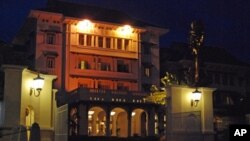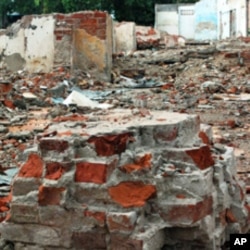Cambodia's capital, Phnom Penh, is in the midst of an architectual transformation. Most of the buildings in the relatively young city are only two or three stories tall. But now much of the city's century-old French colonial architecture is being demolished, to make way for modern high-rises.
The change is being driven Cambodia's dramatic economic growth over the past decade, creating jobs and new infrastructure to one of Asia's poorest countries. A robust economy also means that the capital's old French colonial architecture is being rapidly replaced with modern residential and office high-rises, altering the city's skyline.
Some architects and historians here say as many as 40 percent of the colonial buildings that survived decades of war and the brutal Khmer Rouge government have been demolished in the past 20 years.
Michel Verrot, a French architect and a longtime Cambodian resident, heads the Heritage Mission, a French-funded project trying to preserve what remains of the architecture from 150-year-old French colonial period. Verrot explains that during France's rule, Phnom Penh was designed as a city of gardens, avenues and pleasing views -- now lost in the rush to modernity.
"What is happening is that all the views are becoming very, very disturbed, with things very, very different without any idea, without any global idea of the town development," said Verrot. "This is really today the most important problem. The second one is that everything is done without any general plan. We do the things one after one," Verrot said.
The Heritage Mission has mapped the architectural history of Phnom Penh, and has helped restore several buildings, including the iconic Central Market, which is a favorite with tourists.
And owners have restored a few commercial buildings, like the Hotel le Royal.
Verrot thinks the government has little interest in preserving old buildings. He says that is in part because the gem of Cambodian architecture - the temple complex of Angkor Wat - so dominates discourse that it leaves little space for other types of architecture.
But Cambodia's colonial architectural heritage is also part of the country's history, even if recalling that past can prove uncomfortable.
Cambodia's top culture ministry official Samraing Kimsan says his office's ability to preserve the city's architectual history is limited. The task is made more complicated, he adds, by the attitude of many Cambodians.
"They do not understand or do not love the traditional and old style of building," said Samraing Kimsan. "They do not understand."
Samraing Kimsan says the ministry struggles to educate people to value old buildings despite a lack of money in the budget to preserve historical structures. He adds, the French government has funded some preservation efforts, but that money may not last.
"Everywhere in Cambodia the provincial departments are all French colonialist buildings. So many old buildings are French buildings - [they] need to be restored. France has not much money," Samraing Kimsan said. "But the government needs to get money. But we are now on the way of development."
Samraing Kimsan himself seems less than enthusiastic about colonial buildings, describing them as windy, in need of air-conditioning, and expensive to restore. His preference is to develop a modern, Khmer-style architecture that marries the old with the new.
However, tourism is a key industry here in Cambodia, and the government is encouraging tourists to stay longer than the usual three days at Angkor Wat, in the town of Siem Reap. Verrot says preserving old buildings in Phnom Penh would fit with that aim. He and other preservation advocates also note that renovating old buildings has other benefits.
They say it is much cheaper to renovate than to rebuild. Renovation uses local materials, while new buildings require expensive imported steel and glass.
But the government does not see Phnom Penh as a heritage town, as it does Siem Reap. And critics say that means the focus for the capital is on modernity: glass and marble high-rise towers, as in other Southeast Asian cities, such as Bangkok.










